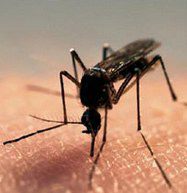
Dichlordifenyltrichlorethan (DDT)
Pesticide DDT is probably the most known case of over-usage of chemical substances by human. DDT was a commonly used insecticide. In a pure form it’s a white powder poorly soluble in water, well in fats.

The first synthesising of DDT was done by an austrian chemist Othmar Zeidler but its ability to function as an insecticide was discovered later, in 1939, by Paul Hermann Müller. DDT helps to eliminate harmful insects in agriculture and bugs in tropical destinations.
Limit of DDT in drinkable water in Czech Republic is set to 0,1 μg/l.
Negative effects
In sixties of 20th century it was proved that DDT cumulates in bodies of animals, even relatively far away from the location where it was used. It caused amongst other low fertility to rodents, it thinned the eggshells of bird eggs, and other negatives which led to an extinction of some species.
Nowadays DDT is forbidden in most of the countries of the world with exception of some evolving countries, for example Africa where it helps to reduce the malaria occurrence.
DDT is toxic, carcinogenic and mutagenic. His produce nowadays is regulated by the so called Stockholm Convention.